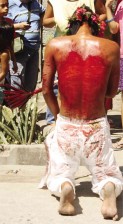Young flagellants abound in Cutud on Good Friday

A “MANDARAME” (flagellant) in Barangay San Pedro Cutud in the City of San Fernando in Pampanga takes part in the Lenten rite to atone for sins and to seek God’s help in healing a sick relative. Photo by E.I REYMOND OREJAS / INQUIRER CENTRAL LUZON
Three boys, who started whipping and wounding their backs at ages 7, 8 and 10 every Good Friday beginning 1995, have stopped doing the bloody rite in Barangay (village) San Pedro Cutud in the City of San Fernando, but flagellation by minors continues in the village despite a ban.
Brothers Raffy, Johan and Regie Juico, considered here to be the youngest flagellants ever, ended their “panata” (vow) in 2010, their sister Emeriza Dimalanta told the Inquirer.
“They have already completed the 15 years of sacrifice they pledged for the healing of our grandfather and mother,” Dimalanta, 29, said.
In 1999 when the Philippine Daily Inquirer found the three boys at the end of a queue of flagellants, they said they were not atoning for sins but were seeking God’s help in curing their grandfather, Boy Miranda, and their mother, Riza, of asthma.
Cutud converts into a local Calvary every Good Friday, becoming the stage for real-life crucifixion by a dozen men, flagellation by a thousand men and the reenactment of the Via Crusis (Way of the Cross).
While the “kaparosa” (black hood) concealed the faces of the Juico brothers, their tiny bodies exposed their young age. Back then, they used “burilyos” (bamboo sticks tied to a rope) to hit the wounds made from the quick pounding of a “panabad” (a hand-sized wooden pad with three rows of glass shards) on their backs.
They ignored admonitions of village leaders, persisting with their vow and brotherhood pact until they reached the proper age and their wishes granted.
Deep, thick scars at the back of Regie, now 28, are distinct signs of their identity as “mandarameng anak” (child flagellants).
In adulthood, one of them met a violent death.
Raffy, known as Bido in Cutud, was beheaded in 2012 by a group of settlers. His head was found on July 8 or eight days after it went missing on June 30, the feast of the village’s patron saint.
No arrest warrant had been issued against the nine suspects, Dimalanta said. “I wish justice is served to Bido. He was kind. He never hurt people,” she said.
Johan, also known around as Bugoy, works as “cobrador” (collector) for a numbers game.
Regie, Egie to friends, drives a “kalesa” (horse-drawn cart). He owns two horses that he maintains at a stable beside the family house.
“We were just kids. We had nothing but we wanted to help our kin. We think flagellation was the best way to ask God for help,” Regie said.
To this day, he said he found nothing wrong with what they did because it was a form of “salpantaya king Guinu” (faith in God).
Their father, Emerito, was a flagellant himself. When his vow was over, he turned into a “manabad” or someone who wounded flagellants.
The Juico brothers were not the last young flagellants, though.
Gabriel Diaz, who said he began his vow at 17 in 2009, said two boys, aged 12 and 14, were in his batch.
Boys joined the Holy Week rite because there was no minimum or maximum age limit for participants, said Leonardo Tiglao, 64, a former village council member.
Joining the rite is not compulsory, said Tiglao who did not follow in the footsteps of his father, Jose.
Diaz, his grandson, took to flagellation for his mother who suffered from a bleeding disorder.
Diaz takes the route of the Juico brothers by starting the flagellation at the Sta. Lucia Church and ending it before noon by rolling on the ground (“salibatbat”) in front of the Metropolitan Cathedral at the heart of the city.
Starting young was part of the tradition, said San Pedro village chief Remegio de la Cruz. In his case, he began at 12 while in Grade 6. It was a sacrifice for his father, Damaso, who was paralyzed. He stopped joining the rite in 1986.
Johnny Pangilinan, who began at 21, said boys, aged 14 and 15, joined his batch of flagellants.
De la Cruz said the village council banned flagellation by minors “in compliance with juvenile protection laws.” “I also advise parents to stop their boys from joining the rite,” he said.
Because registration is required only among men who get themselves crucified in Cutud, documentation of flagellants among boys and men hardly exists.
No government or nongovernment agency has visited Cutud to stop the boys from joining the Lenten rite. The Roman Catholic Church, through the Archdiocese of San Fernando, prohibits violent forms of penance or penitence but its reminders have been ignored.














